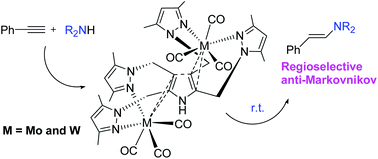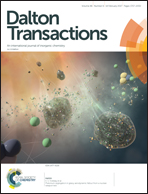The pyrrole ring η2-hapticity bridged binuclear tricarbonyl Mo(0) and W(0) complexes: catalysis of regioselective hydroamination reactions and DFT calculations†
Abstract
Following the report of the ferrocene structure, metal complexes containing the heteroatom-substituted cyclopentadienyl (Cp) analogue, that is the η5 pyrrolyl ligand, have been reported. While the Cp ligand continues to be a favorite ligand in organometallics, the transition metal chemistry of the pyrrolyl ligand is still in the developing stage. In view of this, we carried out the reaction between the multidentate ligand 2,3,4,5-tetrakis(3,5-dimethylpyrazolylmethyl)pyrrole (LH) and Mo(CO)6 or [W(CO)3(CH3CN)3] and isolated two new binuclear tricarbonyl Mo(0) and W(0) complexes, [Mo2(CO)6(μ–η2:η2-LH-κ4N)] (1) and [W2(CO)6(μ–η2:η2-LH-κ4N)] (2). Their X-ray structural analyses showed that the metal centers are bridged by the double bonds of the central pyrrole ring (μ–η2:η2), a rarely observed coordination mode. Interestingly, complex 1 is a catalyst precursor for the hydroamination reactions of phenylacetylene with a series of secondary amines at room temperature offering the regioselectively formed anti-Markovnikov product in excellent yields. In addition, DFT calculations were performed to understand the bonding nature of the pyrrole ring in 1 and 2 and to estimate the energy of six different conformations of LH.



 Please wait while we load your content...
Please wait while we load your content...